
Ceanothus is a genus of about 50–60 species of nitrogen-fixing shrubs and small trees in the buckthorn family (Rhamnaceae). Common names for members of this genus are buckbrush, California lilac, soap bush, or just ceanothus. "Ceonothus" comes from Ancient Greek: κεάνωθος (keanōthos), which was applied by Theophrastus to an Old World plant believed to be Cirsium arvense.
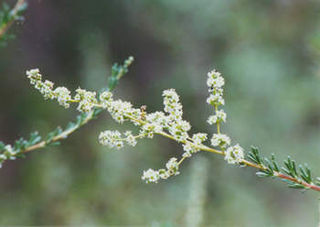
Adenostoma fasciculatum, commonly known as chamise or greasewood, is a flowering plant native to California and Baja California. This shrub is one of the most widespread plants of the California chaparral ecoregion. Chamise produces a specialized lignotuber underground and at the base of the stem, known as a burl, that allow it to resprout after fire has off burned its stems. It is noted for its greasy, resinous foliage, and its status as one of California's most iconic chaparral shrubs.

Ceanothus integerrimus, known by the common name deer brush, is a species of woody shrub in the family Rhamnaceae, native to the western United States in Arizona, New Mexico, California, Oregon, and Washington. It grows in montane chaparral and woodlands regions, in hardwood forests, and in fir, spruce, and Ponderosa pine plant communities, being most abundant in the California chaparral and woodlands and Sierra Nevada.

Ceanothus crassifolius is a species of flowering shrub known by the common name hoaryleaf ceanothus. This Ceanothus is found throughout the coastal mountain ranges of the southern half of California, and its range extends into Baja California.
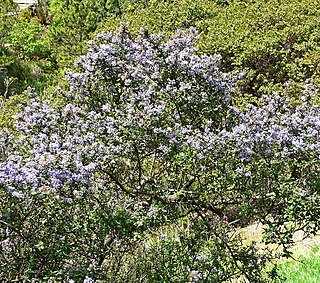
Ceanothus impressus is a species of shrub in the family Rhamnaceae known by the common name Santa Barbara ceanothus. It is endemic to the Central Coast of California, where it is known from San Luis Obispo and Santa Barbara Counties. It occurs in chaparral habitat.

Sambucus racemosa is a species of elderberry known by the common names red elderberry and red-berried elder.

Ceanothus spinosus, with the common names greenbark and redheart, is a species of Ceanothus. It is native to southern California and northern Baja California, where it grows in the scrub and chaparral of the coastal mountain ranges.

Cercocarpus betuloides is a shrub or small tree in the rose family. Its common names include mountain mahogany and birch leaf mountain mahogany The common name "mahogany" comes from the hardness and color of the wood, although the genus is not a true mahogany.

Ceanothus dentatus is a species of shrub in the family Rhamnaceae known by the common name sandscrub ceanothus. It is endemic to California, where it is known only from the Central Coast and its Coast Ranges. It grows in coastal hills, bluffs, and canyons.

Ceanothus gloriosus is a species of shrub in the family Rhamnaceae known by the common name Point Reyes ceanothus. It is endemic to California, where it is known from the coastline of the San Francisco Bay Area and areas north and south. It grows on seaside bluffs and the slopes of the coastal mountains. This shrub grows flat and spreading to erect, approaching two meters in maximum size. The evergreen leaves are oppositely arranged and up to 5 centimeters long, rounded to oval in shape. The edges are toothed, the teeth sometimes spine-tipped. The inflorescence is a small cluster of bright blue to purple flowers. The fruit is a horned capsule about 4 millimeters wide.
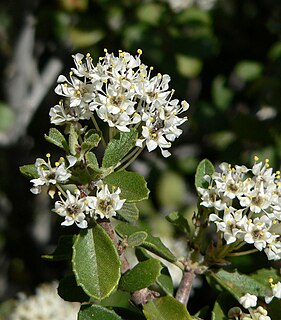
Ceanothus pauciflorus, known by the common name Mojave ceanothus, is a species of flowering shrub in the buckthorn family, Rhamnaceae. It is native to the Southwestern United States and Mexico, where it grows primarily in shrubland communities at moderate to high elevations. It is characterized by oppositely arranged leaves, corky stipules and white flowers. It was formerly known as Ceanothus greggii.
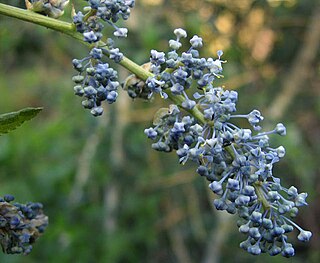
Ceanothus leucodermis, with the common names chaparral whitethorn or chaparral white thorn, is a species of shrub in the family Rhamnaceae. This Ceanothus is an importance browse for several types of ungulate, such as the mule deer and bighorn sheep, who prefer the new growth and shoots to the older, spiny parts.

Ceanothus masonii is a species of shrub in the buckthorn family, Rhamnaceae, known by the common name Mason's ceanothus. It is endemic to Marin County, California, where it is known only from an area near Bolinas on the Point Reyes National Seashore. It grows in the coastal chaparral on the windblown bluffs..

Ceanothus prostratus is a species of shrub in the family Rhamnaceae. Common names include prostrate ceanothus, pinemat, and mahala mat. It is native to the Pacific Northwest of the United States where it grows in coniferous forests and open plateaus.

Ceanothus roderickii is a rare species of shrub in the family Rhamnaceae known by the common name Pine Hill ceanothus. It is endemic to western El Dorado County, California, where it grows in the chaparral and woodlands of the Sierra Nevada foothills, such as the Pine Hill Ecological Reserve. It is named after 20th century California flora explorer, botanist, and arboretum director Wayne Roderick.

Ceanothus sanguineus is a species of shrub in the family Rhamnaceae known by the common name redstem ceanothus. It is native to western North America from British Columbia to Montana to far northern California; it is also known from Michigan. It grows in temperate coniferous forest habitat in forest openings amidst the conifers. This is an erect shrub approaching 3 meters in maximum height. Its stem is red to purple in color, its woody parts green and hairless when new. The deciduous leaves are alternately arranged and up to about 10 centimeters long. They are thin, light green, oval, and generally edged with glandular teeth. The undersides are sometimes hairy. The inflorescence is a cluster of white flowers up to about 12 centimeters long. The fruit is a three-lobed smooth capsule about 4 millimeters long. This shrub is an important food plant for wild ungulates such as the Rocky Mountain Elk, it is browsed eagerly by many types of livestock, and the seed is consumed by many types of animals.
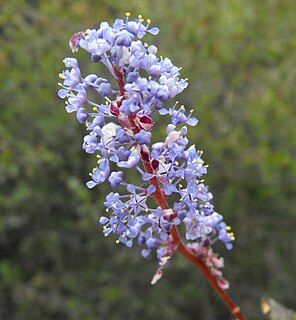
Ceanothus tomentosus, with the common name woollyleaf ceanothus, is a species of shrub in the family Rhamnaceae. It is native to several of the mountain ranges in California and Baja California.

Chrysothamnus viscidiflorus is a species of shrub in the daisy family of the Americas known by the common names yellow rabbitbrush and green rabbitbrush.

Lonicera subspicata is a species of honeysuckle known by the common name southern honeysuckle. It is native to Baja California, California, and northern Baja California Sur, where it is known from several areas in mountain and coastal habitat, particularly chaparral. It is a vining shrub which usually climbs on other plants for support.
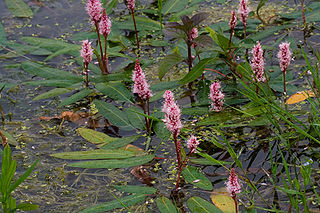
Persicaria amphibia is a species of flowering plant in the knotweed family known by several common names, including longroot smartweed, water knotweed, water smartweed, and amphibious bistort. It is native to much of North America, Asia, Europe, and parts of Africa, and it grows elsewhere as an introduced species and sometimes a noxious weed.




















